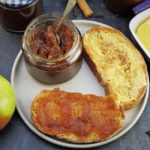
Apple Butter
Fruit butters (which don't actually contain any dairy) are traditional and concentrated fruity preserves.
Here, apples are cooked with spices, water, sugar and optional cider to make a caramelised spread for toast, stirring into yogurt and porridge, or even eating with cheese or other savoury dishes such as pork and sausages.
Ingredients
- 1 kg cooking apples e.g. Bramleys approx 4 large apples
- 1-2 tsp ground cloves
- 1-2 tsp ground cinnamon
- 500 ml cider see Recipe Notes if you wish to leave it out
- water see Instructions for amount
- 800-1050 g sugar brown, white or a combination
Instructions
-
Wash 5 - 6 small jars (capacity approx 150 ml each) and their lids in hot, soapy water, rinse, then leave upside down to drain.
Optional: put 2 saucers or small plates in the fridge or freezer to test for a setting point later.
-
Wash and roughly chop the apples without peeling or coring them.
Put into a preserving pan or large, wide saucepan.
Add ½ tsp each of the ground cloves and cumin.
Pour over the cider if using.
Add enough water to just cover the apples, stir and put on a lid.
Bring to a boil, take off the lid and reduce the heat to a simmer.
Cook until the apples are very soft and falling apart. (10-15 min).
-
Put a sieve over a large bowl and pour in the cooked apple mixture (you may need to do this in batches).
Stir and press the contents of the sieve so that all the pulp is forced into the bowl, leaving behind just the skin and pips which can be discarded.
Wash and dry the saucepan.
-
Measure the volume of the pulp using a measuring jug, in batches if necessary, then transfer it to the clean pan. If you're at all forgetful, write down the volume!
-
Calculate the weight of sugar required using one of the following formulas. In the examples, I've assumed 1400ml of pulp: replace this with your own measurement.
For apple butter that is sweet but still good with savoury foods such as cheese: use 60% sugar to pulp e.g. (60 x 1400) / 100 = 840g sugar.
For sweet apple butter: use 75% sugar to pulp e.g. (75 x 1400) / 100 = 1050g sugar.
Amounts of sugar do not have to be exact so you can round up or down.
-
Stir the sugar into the pulp in the pan along with another level teaspoon each of the ground cloves and cinnamon.
Put the lid on and bring to a boil, then take it off and reduce the heat to a gentle simmer.
-
Meanwhile: switch your oven to its lowest setting and put the jars and lids on a baking traying inside.
Switch the oven off when the jars are hot, but leave in the oven so they stay hot.
-
Cook until the apple butter is very thick and dark, stirring often to ensure it isn't sticking to the bottom of the pan and to encourage evaporation (25-40 min).
While it's cooking, taste and add the final half teaspoons of the spices if liked.
How to tell when it's ready:
- the mixture should cling easily to a spoon.
- if you draw a spoon across the bottom of the pan, no loose liquid should run into the space.
- if a spoon drawn across the top of the mixture leaves a definite impression then the butter is likely to have a firm rather than soft set.
- if unsure, you can test for a setting point: put a teaspoonful on one of the cold saucers: leave for a few moments until the apple butter is cold then push it with your finger. If it wrinkles then it's set. If not, cook another 5 minutes and test again.
-
Pour into the prepared, hot jars. Protecting your hands with a cloth, immediately put on the lids and leave to cool.
-
When cool enough to handle, tighten the lids a little more if possible.
Label when completely cold.
Can be used straight away, or should keep for at least 6 months in a cool, dark place providing the jars have an airtight seal. See Recipe Notes to check for an airtight seal.
Store in the fridge once opened and use within 7-14 days.
Recipe Notes
Note #1 If you prefer, you can use all water rather than cider. To replace its tartness, you may wish to include the juice of a lemon instead.
Note #2 When the jars are completely cold, check for an airtight seal by pressing down in the centre of the lid.
If the centre does not pop back up then you have an airtight seal. If the centre pops back up then you have 2 options:
- Store the preserve in the fridge and use within 2 weeks.
- Remove the preserve from the jars and re-boil it. Re-wash and prepare the jars and lids as before. Pot up again while the preserve and jars are hot. Test for an airtight seal as above when cold.